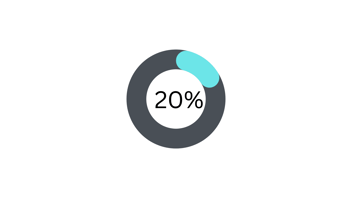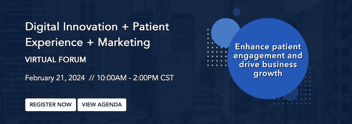Session Recap from Becker's PX & Marketing Virtual Event, Part 1
The other day I presented at one my favorite virtual events, the Becker's Healthcare Digital Innovation, Patient Experience and Marketing Virtual Event. I have presented at this event for years now, and I am always thrilled by the number of attendees and level of engagement. The content is great. The half day of sessions is just the right amount. And, the people who show up are always really interested in learning about the latest in patient engagement innovations and experiences.
This time, I thought I would recap my session on the blog because the response was so overwhelmingly positive, and several attendees said they thought it was particularly useful. So, here is a quick summary, and if you want to watch the session instead, you can do so here.
The session, Mobile Patient Engagement: Don't Reinvent the Wheel, broke down the 80/20 approach to mobile engagement. It gave an overview of the 80% of things you don't need to do yourself—from building the underlying technology to worrying about app store updates to getting all the basic tools lined up like urgent care wait times, appointment scheduling and bill pay. I then offered suggestions on what you should focus on, which is the 20% of things truly unique to your organization and patients. Finally, we looked at how do you tie it all together and get the most patients to engage on mobile quickly and efficiently.
Patients Want Mobile Engagement
There is not doubt that patients want well-designed digital and mobile solutions that are similar to what they have in other areas of their lives:
- 60% want an experience in healthcare that mirrors retail
- 90% don’t feel obligated to stay with a provider who doesn’t offer a good digital experience
- ¼ of patients would switch providers for a better digital experience
Ninety-two percent of healthcare consumers surveyed say that improving customer experience should be a top strategic priority for medical providers.
- 2/3 want online scheduling
- Half of patients would consider switching for digital intake and registration
- 68% of patients prefer electronic payment options
- 80% of patients prefer electronic communication with providers at least some of the time
CIOs have reported concerns about effectively supporting and operationalizing the pieces of their digital strategy, like a mobile platform. This is where the 80/20 approach helps reduce the burden. There’s no reason to reinvent the wheel. Instead, the approach the drives maximum engagement with minimum lift is to get a foundational framework to build on, use your best-in-class solutions and off-the-shelf integrations for the 80%, and then, work to implement the other 20%.
The Foundational Framework
Use an existing, tested foundational framework that is cloud-based and compliant and offers the tools you need like a content manager and analytics. That way you can avoid worrying about all the various updates and requirements:
- OS updates
- App store updates
- Amazon
In addition, the pre-built platform will have been designed with the support of user experience experts who think about:
- User stories
- Navigation
- Iconography
- Colors
- Accessibility
The 80%
Eighty percent of the things you need in a mobile engagement platform are the same as everyone else. Looking at what features more than 50% of respondents had in the categories of patient engagement tools in the CHIME Digital Health Most Wired Survey in 2022, it’s evident.
The survey categorizes the features into four areas. In each area there are features that are commonly found among the majority of health systems.
- Orienting
- Introducing the care environment
- Mobile Check in
- Click to call
- Enlightening
- Access to education
- Access to education videos
- Non-english access
- Health library
- Health maintenance campaigns
- Symptom checker
- Aligning
- Billpay
- Check-in
- Portal access
- Staff recognition
- Surveys
- Email/text appointment reminders
- Personalizing
- Self scheduling
- Virtual visits
- Personal health record
- Chronic condition management
- Remote patient monitoring
- Personal health tracker

